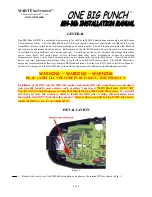
Here is an overview of the functions on the User Control Panel:
On/Off Button
— Press for at least 1 second to turn the Lifeline ARM on or off
Up/Down Buttons
— Use to position the Piston relative to the patient’s chest
Run Compressions
— Press the top button to perform continuous compressions;
press the bottom button to perform compressions with pauses for rescue breaths
Pause Button
— Stops compressions when running or resumes compressions
when stopped
Battery Pack Indicator
— Indicates the approximate remaining Battery Pack capacity
Warning Indicator
— Illuminates to notify the user that there is a problem with the
compression module and immediate attention is needed
Warning Mute Button
— Silences the audible sound associated with a warning
for one minute
Service Indicator
— Will flash to indicate when the Lifeline ARM requires periodic
maintenance
RAC-A1515EN-BA
18
Summary of Contents for Lifeline ARM
Page 2: ......
Page 4: ...RAC A1515EN BA 4 ...
Page 6: ...RAC A1515EN BA 6 ...
Page 10: ...RAC A1515EN BA 10 ...
Page 32: ...RAC A1515EN BA 32 ...
Page 38: ...RAC A1515EN BA 38 ...
Page 40: ...RAC A1515EN BA 40 ...
Page 42: ...RAC A1515EN BA 42 ...
Page 43: ......
Page 44: ......
















































